主谓语一致
主语与谓语一致性

主语与谓语一致性一、主语与谓语一致性主语与谓语一致性是语法学中的一个重要概念,指的是主语和谓语在人称和数方面保持一致。
在句子构成中,主语是句子的核心成分,谓语是对主语进行陈述或描述的动词或动词短语。
只有在主语与谓语之间存在一致性,才能确保句子的逻辑关系和语法正确性。
二、人称一致性在句子中,人称一致性要求主语和谓语在人称方面保持一致。
具体而言,当主语是第一人称(即“我”)时,谓语动词经常使用第一人称的形式,如“am”、“was”等。
当主语是第二人称(即“你”)时,谓语动词常常采用第二人称的形式,如“are”、“were”等。
当主语是第三人称(即“他/她/它”或其他名词)时,谓语动词则使用第三人称的形式,如“is”、“was”、“has”等。
例如:I am a teacher.(我是一名教师。
)You were here yesterday.(你昨天在这里。
)He is a doctor.(他是一名医生。
)三、数一致性数一致性要求主语和谓语在数方面保持一致。
通常,在句子中,主语和谓语动词的单复数形式需要保持一致。
如果主语是单数形式,谓语动词也应该使用单数形式;如果主语是复数形式,谓语动词则使用复数形式。
例如:She plays the piano.(她弹钢琴。
)They are students.(他们是学生。
)四、特殊情况在一些特殊情况下,需要注意特殊的主语和谓语一致性问题。
1.复合主语:当句子中出现有两个或更多个并列主语时,谓语动词的形式取决于这些主语是否为单数或复数。
例如:Tom and Jerry are friends.(汤姆和杰瑞是朋友。
)Milk and bread are on the table.(牛奶和面包在桌子上。
)2.连接词“or”和“nor”:当连接词“or”和“nor”连接两个主语时,谓语动词的形式取决于离谓语动词最近的那个主语。
例如:Tom or his friends are coming.(汤姆或者他的朋友们即将到来。
主谓一致的基本规则及常见例子

主谓一致的基本规则及常见例子主谓一致是指主语在人称和数上与谓语动词保持一致。
主谓一致在语法中起到重要的作用,它决定了句子的正确性和语言的表达清晰度。
本文将介绍主谓一致的基本规则,并给出常见的例子以帮助读者更好地理解和运用。
一、一般现在时中的主谓一致在一般现在时中,主语与谓语动词需要保持一致。
当主语是第三人称单数时,谓语动词要使用第三人称单数形式。
例如:1. He goes to school by bus every day.(第三人称单数主语)2. They go to school by bus every day.(非第三人称单数主语)在第一个句子中,主语"He"是第三人称单数,所以谓语动词"go"也使用了第三人称单数形式"goes"。
而在第二个句子中,主语"They"是非第三人称单数,所以谓语动词"go"保持了原始形式。
二、存在助动词的句子中的主谓一致当句子中存在助动词时,主语与助动词的词形要保持一致。
例如:1. She is reading a book.(动词“be”+现在分词)2. They are reading books.(动词“be”+现在分词)在第一个句子中,主语“She”是第三人称单数,所以助动词“is”也使用了第三人称单数形式。
而在第二个句子中,主语“They”是非第三人称单数,所以助动词“are”保持了原始形式。
三、特殊情况下的主谓一致1. 连接词“either...or...”或“neither...nor...”连接两个主语时,谓语动词要与靠近的主语保持一致。
例如:Neither John nor his friends are going to the party.(“neither...nor...”连接两个主语,谓语动词与靠近的主语"friends"保持一致)2. 当主语为复数形式,但表示整体单一概念时,谓语动词要使用单数形式。
主谓一致
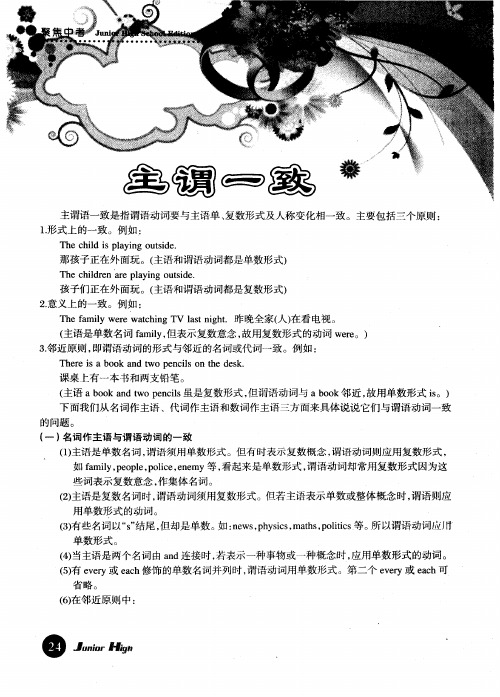
( 主语是复数名词时 , 2 ) 谓语动词须用复数形式。 但若主语表示单数或整体概念时 , 谓语贝 用单数形式的动词。
() 3有些 名词 以“” 尾 , S结 但却是 单数 。 :e ,hs smah,oic 等 。 以谓语 动词 厶 如 nwspyi , tsp lis c t 所 单 数形 式 。 () 4当主语是 两个 名词 由 ad连 接时 , n 若表示 一 种事物 或 一种概 念 时 , 用单数 形 式 的动 应 () eey或 ec 饰 的单数 名词 并列 时 , 语动 词用单 数形 式 。第二 个 ee 或 ec 5有 vr ah修 谓 vr y ah
省略。
() 6在邻 近原则 中 :
Q . n r 盼
・ 基础语 法・
● ● ● ● ● ● ● ● ● ● ● ● ● ● ● ●
J n r i co 1 dt n 聚 焦 中 考 ul g Sh o E io oH h i
● ● ● ● ● ● ● ● ● ● ● ● ● ● ● ● O ● ● ● ● ● ● ● ● ● ● ● ● ● ● ● ●
形式 。
③“ ) a f ( pro +名词” a t 作主语时 , 若名词是单数 , 谓语动词则为单数形式 ; 若名词是复数时 , 谓 语 动词 则为 复数 形式 。 ④ “ ru f ago po +名词 ” 主语 时 , 作 强调 整体 , 动词用 单 数形 式 ; 若强 调 gop中的各 成员 , ru 动
谓语 动词 则用 单数 形 式 。 则为 复数 形式 。 () 8主语 为短语 或 ,子 时 , 语 动词 应用 单数 形 式 。 u J 谓
h h l r n a e p a i g o ti e. T e c id e r l y n u sd
主谓一致的三个原则
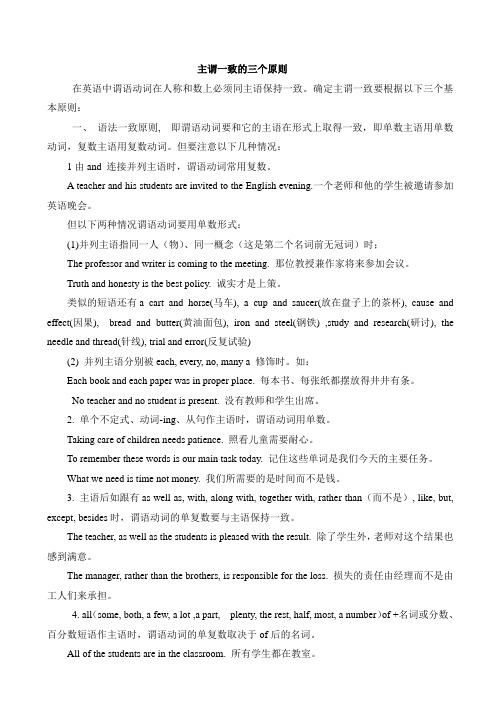
主谓一致的三个原则在英语中谓语动词在人称和数上必须同主语保持一致。
确定主谓一致要根据以下三个基本原则:一、语法一致原则, 即谓语动词要和它的主语在形式上取得一致,即单数主语用单数动词,复数主语用复数动词。
但要注意以下几种情况:1由and 连接并列主语时,谓语动词常用复数。
A teacher and his students are invited to the English evening.一个老师和他的学生被邀请参加英语晚会。
但以下两种情况谓语动词要用单数形式:(1)并列主语指同一人(物)、同一概念(这是第二个名词前无冠词)时;The professor and writer is coming to the meeting. 那位教授兼作家将来参加会议。
Truth and honesty is the best policy. 诚实才是上策。
类似的短语还有a cart and horse(马车), a cup and saucer(放在盘子上的茶杯), cause and effect(因果), bread and butter(黄油面包), iron and steel(钢铁) ,study and research(研讨), the needle and thread(针线), trial and error(反复试验)(2) 并列主语分别被each, every, no, many a 修饰时。
如:Each book and each paper was in proper place. 每本书、每张纸都摆放得井井有条。
No teacher and no student is present. 没有教师和学生出席。
2. 单个不定式、动词-ing、从句作主语时,谓语动词用单数。
Taking care of children needs patience. 照看儿童需要耐心。
To remember these words is our main task today. 记住这些单词是我们今天的主要任务。
主谓一致的几个原则
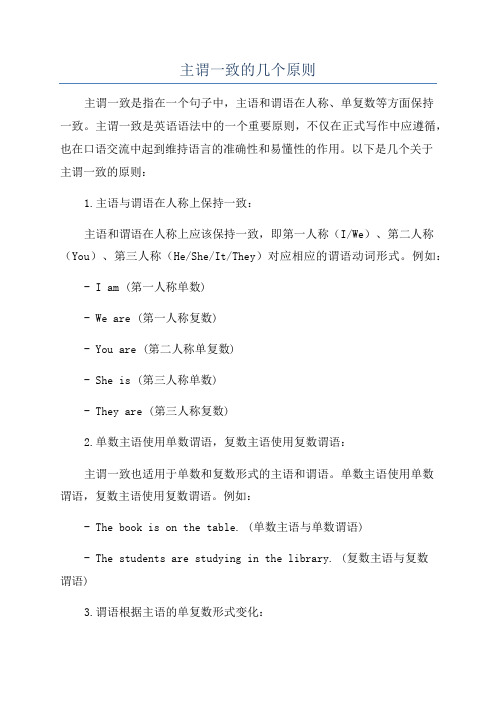
主谓一致的几个原则主谓一致是指在一个句子中,主语和谓语在人称、单复数等方面保持一致。
主谓一致是英语语法中的一个重要原则,不仅在正式写作中应遵循,也在口语交流中起到维持语言的准确性和易懂性的作用。
以下是几个关于主谓一致的原则:1.主语与谓语在人称上保持一致:主语和谓语在人称上应该保持一致,即第一人称(I/We)、第二人称(You)、第三人称(He/She/It/They)对应相应的谓语动词形式。
例如:- I am (第一人称单数)- We are (第一人称复数)- You are (第二人称单复数)- She is (第三人称单数)- They are (第三人称复数)2.单数主语使用单数谓语,复数主语使用复数谓语:主谓一致也适用于单数和复数形式的主语和谓语。
单数主语使用单数谓语,复数主语使用复数谓语。
例如:- The book is on the table. (单数主语与单数谓语)- The students are studying in the library. (复数主语与复数谓语)3.谓语根据主语的单复数形式变化:谓语动词的形式会根据主语的单复数形式而发生变化。
一般情况下,复数主语使用谓语动词的原形,而单数主语使用谓语动词的第三人称单数形式。
例如:- The dog barks. (单数主语使用第三人称单数动词形式)- The dogs bark. (复数主语使用动词原形)4.不定代词与谓语要保持一致:在使用不定代词作为主语时,谓语动词的形式要与不定代词的数保持一致。
例如:- Somebody has left their bag. (不定代词somebody与谓语动词has保持一致)5.基于语法结构的主谓一致:有些复杂的语法结构,在主谓一致上需要更多的注意。
例如:- 以either...or...、neither...nor...、not only...but also...连接两个主语时,谓语动词的形式要与靠近的主语保持一致,例如:- Either John or his friends are going to the party. (谓语动词与靠近的主语friends保持一致)- Neither the teacher nor the students were present. (谓语动词与靠近的主语students保持一致)- 当主语由as well as、along with、together with等短语结构引出时,谓语动词的形式要与前面的主语保持一致- The book, as well as the pen, is on the table. (谓语动词与前面的主语book保持一致)- 当主语由there is/are开头时,谓语动词的形式要与后面的主语保持一致,例如:- There is a book on the table. (谓语动词与后面的主语book保持一致)- 当主语由a number of、a majority of、the majority of等短语开头时,谓语动词的形式要与后面的名词保持一致,例如:总之,主谓一致是英语语法中的重要原则,人们在使用英语时应该根据主语的单复数形式、人称以及语法结构等因素,正确选择与之相对应的谓语动词形式。
主谓一致的原则

主谓一致的原则主谓一致是英语语法中的基本原则之一,指的是主语和谓语在人称和数上要保持一致。
主谓一致的正确运用能够使句子表达更加准确,符合语言规范。
本文将详细介绍主谓一致的原则,并通过一些例子来加深理解。
一、基本原则在英语句子中,主语和谓语之间必须保持一致,具体包括以下几个方面:1. 人称一致:主语是第一人称(I、we)、第二人称(you)或第三人称(he、she、it、they)时,谓语动词的形式必须与之一致。
例如:- I am a student.(我是一名学生。
)- He sings beautifully.(他唱得很美。
)2. 数一致:主语是单数形式时,谓语动词的形式也要用单数;主语是复数形式时,谓语动词的形式也要用复数。
例如:- The dog barks loudly.(这只狗叫得很大声。
)- The birds are chirping.(鸟儿正在鸣叫。
)3. 特殊情况:有些特殊情况下,主谓一致的原则会有一些变化。
例如:- 不定代词:somebody, anybody, nobody, everybody等当作主语时,谓语动词形式使用第三人称单数形式。
例如:Nobody wants to go with me.(没有人想和我一起去。
)- 连接词:and连接的主语,如果表示同一个人或物时,谓语动词的形式使用第三人称单数形式;如果表示不同的人或物时,谓语动词的形式使用第三人称复数形式。
例如:Tom and Jerry is a famous cartoon.(汤姆和杰瑞是一部著名的卡通片。
)The boys and girls are playing in the park.(男孩和女孩们正在公园里玩耍。
)二、例题分析为了更好地理解主谓一致原则,以下通过一些例题来进行详细分析。
例题1:The team _____ working on the project.(be)在这个例句中,主语是"the team",是单数形式,因此谓语动词的形式应该使用单数,填入be的单数形式"is",句子变为:"The team is working on the project."例题2:He and his friends _____ going to the concert.(be)在这个例句中,主语是"he and his friends",表示多个人,因此谓语动词的形式应该使用复数,填入be的复数形式"are",句子变为:"He and his friends are going to the concert."例题3:One of the students _____ the exam.(fail)在这个例句中,主语是"one of the students",表示多个学生中的一个,因此谓语动词的形式应该使用第三人称单数,填入fail的第三人称单数形式"fails",句子变为:"One of the students fails the exam."三、常见错误在使用主谓一致时,常见的错误包括以下几种:1. 混淆主谓的人称和数:主语与谓语之间的人称和数要保持一致,不可以混淆。
英语主谓一致的三个原则

英语主谓一致的三个原则英语中的主谓一致是指主语和谓语在人称(第一人称、第二人称和第三人称)、数(单数和复数)和人称(第一人称、第二人称和第三人称)方面要保持一致。
下面是主谓一致的三个原则:1.第一人称主语与谓语动词保持一致:当主语是第一人称,即指说话人自己时,谓语动词要用第一人称的形式,即单数一致。
例如:- I am going to the store.(我要去商店。
)- We are going to the store.(我们要去商店。
)2.以及第二人称主语与谓语动词保持一致:当主语是第二人称,即指与说话人进行交流的人时,谓语动词要用第二人称的形式,即单数或复数一致。
例如:- You are my best friend.(你是我最好的朋友。
)- You all are my best friends.(你们都是我最好的朋友。
)3.并且第三人称主语与谓语动词保持一致:当主语是第三人称,即指除了说话人和听话人之外的其他人或物时,谓语动词要用第三人称的形式,根据主语的单复数来确定。
例如:- He is going to the store.(他要去商店。
)- They are going to the store.(他们要去商店。
)需要注意的是,存在一些特殊情况需要特别注意:- 当主语由连接词"and"连接时,如果主语是两个单数名词,则谓语动词要用复数形式;如果主语是一个单数名词和一个复数名词,则谓语动词要与靠近它的名词保持一致。
例如:- Tom and Jerry are playing soccer.(汤姆和杰瑞正在踢足球。
)- The cat and the dogs are eating.(猫和狗正在吃饭。
)- 当主语是由 either...or 或 neither...nor 连接时,谓语动词要与靠近它的名词保持一致。
例如:- Neither John nor his friends are going to the party.(约翰和他的朋友们都不去参加派对。
主谓一致

主谓一致
3-4两个抽象名词用作主语时 谓语动词用单数或复数均可。例如 两个抽象名词用作主语时, 谓语动词用单数或复数均可。例如: 两个抽象名词用作主语时 • His courage and endurance is (或are) admirable . 他的勇气 或 和耐心令人称赞。 和耐心令人称赞。 • Care and understanding is (或are ) important . 关怀和理解 或 是重要的。 是重要的。 当justice and law(正义与法律 , time and tide(岁月 , fairness 正义与法律) 岁月) 正义与法律 岁月 and impartiality(公正和不偏不倚 等作主语时 故谓语用单数或 公正和不偏不倚)等作主语时 公正和不偏不倚 等作主语时, 复数均可
主谓一致
• 意义一致
• 1)逻辑一致是指谓语动词的形式不取决于主语的表层语法形 ) 而取决于它的深层逻辑含义。虽然一个做主语的名词的形 深层逻辑含义 态,而取决于它的深层逻辑含义。虽然一个做主语的名词的形 式是单数,但如果它表示的是复数的含义 谓语动词也应用复 复数的含义, 式是单数,但如果它表示的是复数的含义,谓语动词也应用复 数形式,反之亦然。 数形式,反之亦然。有时同一个词在不同的语境表示不同的逻 辑意义,则需要依据其含义使用不同的动词形式,应注意体味、 辑意义,则需要依据其含义使用不同的动词形式,应注意体味、 把握不同的动词形式,应注意体味、 把握不同的动词形式,应注意体味、把握不同的动词形式所体 现的主语的确切的逻辑含义:离、金额、重量、面积、体积、容积等 时间、 2-1. 表示时间、距离、金额、重量、面积、体积、容积等 度量的名词短语做主语时, 名词短语做主语时 度量的名词短语做主语时,谓语用单数 Two weeks was too long . Eighty dollars is what she needs . 她需要 美元。 她需要80 美元。 Ten apples is enough . ( = Such a number of apples) •Note: 但若强调这类词组的复数意义, 谓语动词也可用复数 但若强调这类词组的复数意义 形式。例如: 形式。例如 Two hundred tons of water were used last month . 上个月用 吨水。 了200 吨水。 The fifty miles were covered by the winner in three hours . 优胜者花3 小时跑完了50 英里路程。 优胜者花 小时跑完了 英里路程。
主谓一致最全面讲解
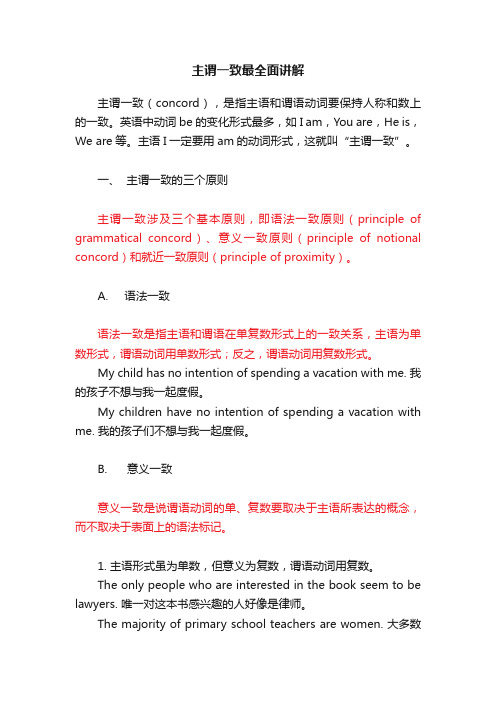
主谓一致最全面讲解主谓一致(concord),是指主语和谓语动词要保持人称和数上的一致。
英语中动词be的变化形式最多,如I am,You are,He is,We are等。
主语I一定要用am的动词形式,这就叫“主谓一致”。
一、主谓一致的三个原则主谓一致涉及三个基本原则,即语法一致原则(principle of grammatical concord)、意义一致原则(principle of notional concord)和就近一致原则(principle of proximity)。
A. 语法一致语法一致是指主语和谓语在单复数形式上的一致关系,主语为单数形式,谓语动词用单数形式;反之,谓语动词用复数形式。
My child has no intention of spending a vacation with me. 我的孩子不想与我一起度假。
My children have no intention of spending a vacation with me. 我的孩子们不想与我一起度假。
B. 意义一致意义一致是说谓语动词的单、复数要取决于主语所表达的概念,而不取决于表面上的语法标记。
1. 主语形式虽为单数,但意义为复数,谓语动词用复数。
The only people who are interested in the book seem to be lawyers. 唯一对这本书感兴趣的人好像是律师。
The majority of primary school teachers are women. 大多数小学老师都是女的。
2. 主语形式为复数,而意义上却是单数,谓语动词用单数。
Billiards is becoming more and more popular in some cities. 桌球在一些城市里越来越受欢迎。
C. 就近一致就近一致是指当主语由两个或两个以上名词或代词组成时,谓语动词的数要与它紧邻的名词或代词的数一致。
主谓一致的规则与注意点
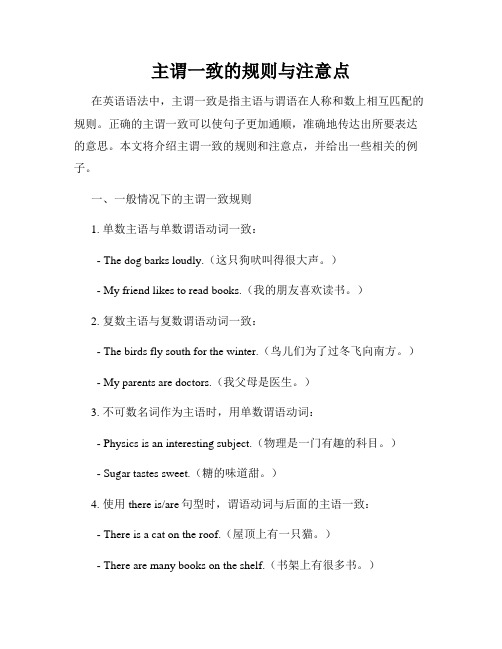
主谓一致的规则与注意点在英语语法中,主谓一致是指主语与谓语在人称和数上相互匹配的规则。
正确的主谓一致可以使句子更加通顺,准确地传达出所要表达的意思。
本文将介绍主谓一致的规则和注意点,并给出一些相关的例子。
一、一般情况下的主谓一致规则1. 单数主语与单数谓语动词一致:- The dog barks loudly.(这只狗吠叫得很大声。
)- My friend likes to read books.(我的朋友喜欢读书。
)2. 复数主语与复数谓语动词一致:- The birds fly south for the winter.(鸟儿们为了过冬飞向南方。
) - My parents are doctors.(我父母是医生。
)3. 不可数名词作为主语时,用单数谓语动词:- Physics is an interesting subject.(物理是一门有趣的科目。
)- Sugar tastes sweet.(糖的味道甜。
)4. 使用there is/are句型时,谓语动词与后面的主语一致:- There is a cat on the roof.(屋顶上有一只猫。
)- There are many books on the shelf.(书架上有很多书。
)二、特殊情况下的主谓一致规则1. 当主语由“each”, “every”, “either”, “neither”等修饰时,谓语动词用单数形式:- Each student needs to bring their own pen.(每个学生都需要带上自己的钢笔。
)- Neither of them is available tomorrow.(他们中的任何一个明天都不可用。
)2. 当主语由“either...or”, “neither...nor”, “not only...but also”等连接时,谓语动词与最靠近的主语一致:- Either the cat or the dogs are sleeping.(要么猫要么狗正在睡觉。
主语和谓语保持一致叫主谓一致
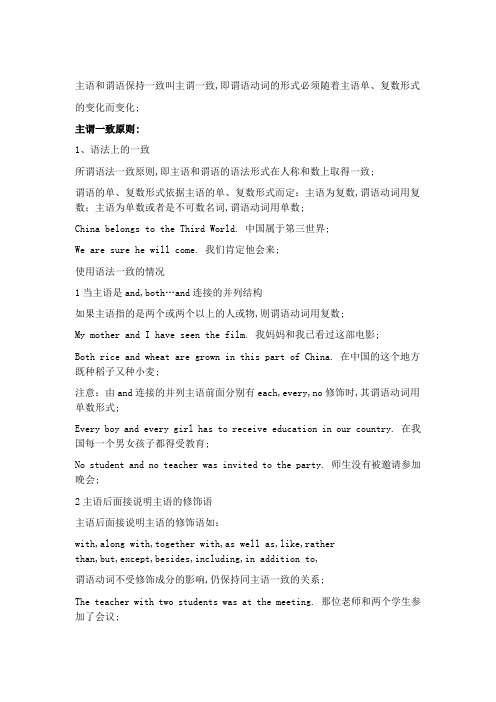
主语和谓语保持一致叫主谓一致,即谓语动词的形式必须随着主语单、复数形式的变化而变化;主谓一致原则:1、语法上的一致所谓语法一致原则,即主语和谓语的语法形式在人称和数上取得一致;谓语的单、复数形式依据主语的单、复数形式而定:主语为复数,谓语动词用复数;主语为单数或者是不可数名词,谓语动词用单数;China belongs to the Third World. 中国属于第三世界;We are sure he will come. 我们肯定他会来;使用语法一致的情况1当主语是and,both…and连接的并列结构如果主语指的是两个或两个以上的人或物,则谓语动词用复数;My mother and I have seen the film. 我妈妈和我已看过这部电影;Both rice and wheat are grown in this part of China. 在中国的这个地方既种稻子又种小麦;注意:由and连接的并列主语前面分别有each,every,no修饰时,其谓语动词用单数形式;Every boy and every girl has to receive education in our country. 在我国每一个男女孩子都得受教育;No student and no teacher was invited to the party. 师生没有被邀请参加晚会;2主语后面接说明主语的修饰语主语后面接说明主语的修饰语如:with,along with,together with,as well as,like,ratherthan,but,except,besides,including,in addition to,谓语动词不受修饰成分的影响,仍保持同主语一致的关系;The teacher with two students was at the meeting. 那位老师和两个学生参加了会议;The girl as well as the boys has learned to drive a car. 这个姑娘和男孩子一道,也学会了开汽车;A library with five thousand books is offered to the nation as a gift.一个有5000册书的图书馆作为礼物赠送给了国家;E-mail, as well as telephones, is playing an important part in daily communication.电邮和电话在日常的通信中起着很重要的作用;Nobody but Jane knows the secret.只有简知道这个秘密;All but one were here just now. 刚才除了一个人外都来了;3非谓语动词或从句作主语非谓语动词动词的-ing形式、不定式或从句作主语时,谓语一般用单数形式;When and where to build the new factory is not decided yet.什么时候在什么地方建新工厂还没定下来;Checking information is very important. 核实事实是非常重要的;To learn foreign languages is not easy. 学习外语并非易事;When we will hold the meeting is not decided yet. 我们何时开会尚未决定;注意:当what引导主语从句或由 and连接两个动词不定式或动名词作主语时,谓语动词的数应根据意义一致的原则来决定;What we need here is money.我们这里需要的是资金;What we need here are workers.我们这里需要的是工人;Lying and stealing are immoral.说谎与偷窃是不道德的;4each和复合不定代词作主语each和some/any/no一个比一个差;Nobody knows the answer. 没有一个人知道这答案;Someone wants to see you. 有人想见你;Is there anything in the box箱子里有什么东西吗There is a lot of milk in the bottle. 瓶子里有很多奶;5“many a +单数名词”作主语“many a、很多/more than one不只一个+单数名词”作主语时,谓语动词用单数形式;Many a student has been to Beijing. 很多学生去过北京;There is more than one answer to your question. 你的问题不只有一个答案;6“one of+复数名词十定语从句”之前有the等限定词和修饰语“one of+复数名词十定语从句”之前有the only,the very,the等限定词和修饰语时,定语从句的谓语动词用单数形式;Tom is the only one of those boys who is willing to help the old man.汤姆是唯一的一个愿意帮助那个老人的男孩;He is the only one of the students who has been a winner of scholarship for three years.他是这三年来唯一的一个获得奖学金的学生;注意:如没有这些限定词和修饰语,定语从句的谓语动词采用复数形式;Tom is one of the boys who are always ready to help others. 汤姆是个随时愿意帮助别人的男孩;7由两个部分组成的物体名词作主语英语中有些由两个部分组成的物体名称如g1asses眼镜,scissors剪刀,shorts 短裤,shoes鞋子,trousers裤子等作主语,其后的谓语动词用复数形式;His glasses were broken, so he can't see well. 他的眼镜碎了,因而看不清楚;His trousers are made of cotton. 他的裤子是棉布的;注意:若这类名词前带有pair等表示单位的名词时,则以这些名词的单、复数形式决定动词的形式;Two pairs of trousers are missing. 两条裤子不见了;This pair of shoes is not on sale. 这双鞋不出售;2、意义上的一致意义上的一致是指谓语动词与主语的一致取决于主语所表达的意义;若主语形式上为复数,而意义上是单数,动词要用单数;若主语形式上为单数,而意义上为复数,则动词用复数;The United States is in North America. 美国在北美洲;The police are looking into the matter. 警察正在调查此事;使意义上的一致的情况1由and连接两个并列主语其后的谓语动词一般用复数形式;但如果两个单数名词指同一个人、同一事物、单一概念时,谓语动词要用单数,有时两个名词共用一个冠词;The worker and writer has written a new novel. 这位工人兼作家写了一部新小说;两个名词共用一个冠词There is a journalist and writer living in America whose name is Alex Haley. 在美国有一个名叫亚利克斯哈利的记者兼作家;Truth and honesty is always the best policy. 真诚总是上策;注意:用and连接起来的两个单数主语,谓语动词可以是单数,也可以是复数;Three and five makes /make eight.三加五等于八;Time and tide wait/waits for no man .岁月不等人;2形复意单的名词作主语①复数形式的专有名词表示国家、城市、机构、组织以及书籍、报纸、杂志等做主语,通常作为整体看待,谓语动词用单数;The United States is in North America.美国在北美洲;The Arabian Nights is read all over the world.天方夜谭是流传世界各地的名着;The New York Times has a wide circulation.纽约时报销路很广;注意:表示山脉、群岛、瀑布等的专有名词和以复数形式出现的表示同姓的一家人或同名、同姓的若干人,谓语也用复数;The Alps rise over 4 countries.阿尔卑斯山脉跨越了四国;Niagara Falls are not as high as Victoria Falls.尼亚加拉瀑布没有维多利亚瀑布高;The Smiths were also invited.史密斯一家人也受到了邀请;There are 3 Marys and 2 Roberts in my class.我班有三个叫玛丽、两个叫罗伯特的学生;②以-ics结尾表示学科的名词做主语,通常表示单数意义,谓语动词用单数形式;这类名词有:physics, politics, mathematics, economics, athletics, electronics等;Politics is now taught in all schools.现在各学校都开设政治课;Economics is a science of the way in which industry and trade produce and use wealth.经济学是研究工业、贸易生财和用财之道;注意:当这些动词表示有关方面的活动、情况、见解、原理等意思时,谓语动词需用复数形式;What are his politics他的政见如何The economics of national growth are of the greatest importance to all modern governments.国家发展经济的原理对现代各国政府都重要;③news,maths,plastics,physics,works,means方法,the United States等虽然以-s结尾,但意义上作为单数看待;“News of victories keeps pouring in as our army advances,” the company commander said. 集团军司令说:”随着我们军队的推进胜利的消息接踵而至;”Mathematics/Physics is a required subject for us.数学/物理是我们必修的科目;Every possible means has been used to prevent the air pollution,but the sky is still not clear.所有可能的直至污染的方法都用了,但天空还是不晴朗的;④成对的名词做主语时用单数形式;Bread and butter is a daily food in the West .面包抹黄油是西方人每天的食品;His gratitude and devotion to the Party is endless.他无限感觉,无限忠于党;⑤“one and a half +复数名词”做主语,谓语动词用单数;One and a half pears is left on the table .一只半梨剩在桌子上;One and a half days is all I can spare.一天半是我所能挤出的全部时间;注意:“one or two+复数名词”做主语,谓语动词用复数;One or two days are enough to see the city.参观该市一两天就足够了;There are one or two things I want to talk over with you .我有一两件事想跟你商量;3有生命的集体名词作主语有生命的集体名词如people,police,cattle,militia作主语,谓语动词用复数形式;Cattle are also kept. 还养了一些牛;There are many people there. 那里有很多人;The police are looking for the thief. 公安人员在搜寻那个小偷;All the people of the world want peace.全世界人民都渴望和平;注意:family,team,class,government,audience,crew,committee等集体名词,如果作整体看待,谓语动词用单数形式;如果作个别成员看待,谓语动词用复数形式;people作“民族”解时,作单数用;Zhang’s family is rather big, with twelve people in all.张家很大,一共12口人;The family are sitting at the breakfast table. 这家人正坐在早餐桌旁;My family is a large one. 我家是个大家庭;The class are doing experiment in the lab. 全班同学正在实验室里做实验;The class has won the honour. 这个班获得了荣誉;The Chinese people is a great people.中华民族是一个伟大的民族;4 名词化的形容词作主语名词化的形容词作主语,按照意义一致的原则决定谓语动词的单、复数形式;如果指一类人,谓语动词用复数形式,如果指一个人或抽象概念,谓语动词用单数形式;这类形容词有:old, young, rich, poor, blind, deaf, dead, sick等;The rich are not always happy. 富人也有不开心的时候;The wounded is a policeman. 受伤者是一名警察;The beautiful is not always the same as the good. 漂亮的不一定就等于好;5 表示时间、距离、金钱、重量等的复数名词作主语表示时间、距离、金钱、重量、度量、容量、温度等的复数名词做主语,通常看作一个整体,谓语动词用单数形式;Twenty years has passed since we left school. 我们离开学校已经20年了;Ten thousand dollars is a lot of money. 一万美元是一大笔钱;Two months is quite a long time. 两个月时间是很长的;Two hours is enough for us to do this experiment.我们做这个实验两个小时就够了;Thirty kilometres is a good 公里是一个相当远的距离;注意:如果说话人侧重一个个的个体,谓语动词用复数形式;Twenty years have passed since we parted.自从我们分手以后20年己经过去了;6“a number of十复数可数名词”与“the number of十复数可数名词”作主语“a number of十复数可数名词”表示“一些、许多”的意思,谓语动词用复数;“the number of十复数可数名词”表示“……的数目、数量”,谓语动词用单数;The number of people invited was fifty, but a number of them were absent for different reasons.邀请来的人数是50,但很多人因不同的原因没来;A number of books are missing from the library.图书馆丢了许多书;The number of workers in this factory is increasing.这家工厂的工人数目正在增加;7none of和neither of后跟复数名词或复数代词作主语none of和neither of后跟复数名词或复数代词时,有时作单数看待,有时作复数看待,主要根据说话人的意思决定;None of them has arrived yet at the settlement. 他们没有一个到达新住宅区;None of them have arrived yet. 他们都还没到;8“分数/百分数+of短语”作主语“分数/百分数+of短语”作主语,这时要以of短语中的名词是否为复数而定;Two fifths of the land in that district is covered with trees and grass.该地区五分之二的土地为树木和草所覆盖;89% of smokers are male. 89%的吸烟者是男性;In the USA, 75% of the grain is used to feed animals. 在美国,75%的谷物用来喂养动物;Two-thirds of the earth's surface is sea. 地球表面的2/3是海洋;Two-thirds of the people were against the plan. 2/3的人都反对核计划;9表示部分概念或不定数量的名词或代词作主语表示部分概念或不定数量的名词或代词作主语,谓语动词用单数还是复数,应根据后接名词的单、复数形式而定;这些名间或代词有all,any,enough,half,more,most,the rest,part,some等;The rest of the buildings are easy to get to. 其余的建筑物并不难上;The rest of his life was happy. 他的晚年生活很幸福;Most of my time was spent in reading. 我大部分时间用来读书;Most of the people are aware of it. 大部分人都知道它;Some of the sugar was spilled on the floor. 一些糖散落在地上;Some of the apples were spilled on the floor. 一些苹果散落在地上;10两个主语,一个肯定,一个否定,谓语动词与肯定主语相一致;The parents, and not the son, were missing.失踪者不是儿子,而是他的双亲;3、邻近原则邻近原则是指谓语动词要与它最邻近的名词或代词保持人称与数的一致;Neither he nor I am a student. 他和我都不是学生;There is a pen , two chairs and a desk. 有一支钢笔,两把椅子和一张桌子;这主要有以下几种情况;1由or,either…or等连接的并列结构作主语由or、either…or、nor、neither…nor、not only…but also、not…but连接的并列主语,通常按照就近一致原则,谓语动词的单、复数形式依照靠近它的主语而定;Either you or the headmaster is to hand out the prizes to these gifted students at the meeting.要么你要么校长在会议上对这些天才的学生颁奖;Neither he nor I have finished the experiment. 他和我都没有做完试验;Either his friends or his brother is wrong. 不是他的朋友们错了,就是他哥哥错了;Not only I but also Jane and Mary are tired of having one examination after another.不仅我而且简和玛丽都讨厌一个接一个的考试;Not only the teacher but also his students have studied the question. 不仅老师而且他的学生们都研究了这个问题;2在主谓倒装句时在主谓倒装句中,主语并列,谓语动词的人称和数与最近的主语相一致;由here或there引导的句子,若有并列主语,谓语也与最靠近的那个主语一致;There is a desk, a table and three chairs in the room. 房间里有一张书桌、一张饭桌和3把椅子;There are three chairs, a desk and a computer in the room. 房间里有3把椅子、一张书桌和一台电脑;Where is your wife and children to stay while you are away你不在时妻子和孩子呆在哪儿"表里不一"现象:以-s结尾的名词作主语的主谓一致:英语可数名词的规则复数形式是在词尾加-s或-es,但是有一些以-s结尾的名词并不是可数名词;它们用法多样,造成了实际使用上的困难,以下详述了以-s结尾的名词作主语的主谓一致问题;一以-s结尾的疾病名称作主语的主谓一致问题二以-s结尾的游戏名称作主语的主谓一致问题三以-s结尾的地理名称作主语的主谓一致问题四以-ics结尾的学科名称作主语的主谓一致问题五其它以-s结尾的名词的主谓一致问题集合名词的主谓一致原则:集合名词作主语时,主谓一致关系是一个较为复杂的问题.对此类问题我们可以从"数"的角度分为四类.1单数—复数型.凡是有复数词尾变化形式的集合名词都属于此类;如:a class—classes; a family—families; a government—governments; an army —armies; a people—peoples; a group—groups; a crowd—crowds; a crew —crews等;这类集合名词强调的是整体性,即当作一个整体或多个整体来看待;属于这类集合名词的单数作主语时,谓语动词用单数;复数形式作主语时,谓语动词用复数;例如A big crowd often gathers on the square every morning.每个上午一大群人经常聚集在广场上The government has decided to pass the bill.政府已决定通过这一法案There are huge crowds in the streets on Sunday.星期天有大群大群的人在街上;There are many English-speaking peoples in the world.在世界上有许多讲英语的人但应注意,这类集合名词的单数形式有时表示复数概念,所以这些集合名词的单数形式也可归为"单复同形型"中.2单数型.这类集合名词表示的是人或事物的整体,即把这类人或事物的全部包括在内,所以只有单数形式.如作主语,谓语动词常用单数;这类名词常见的有:humanity,mankind,proletariat等.例如The proletariat is the greatest class in the history of mankind. In the fields of production and scientific experiment,mankind makes constant progress.3复数型.这类集合名词在形式和内容上是相互矛盾的,就是说它们只有单数形式,但表达的都是复数概念;它强调的是集体中的个体性.这类名词有:police,cattle,faculty,flock,machinery,vermin,personnel等.它们作主语时,谓语动词要用复数.例如The police have caught the murder.Our personnel are very highly trained.The vermin are very dangerous.4单复同形型.这类集合名词的单数形式既可表示单数也可表示复数.作主语时,用单数动词或复数动词均可,有时意义区别不大.例如The school teaching staff are is excellent.The public is are requested not to litter in the park.The teaching profession claims to be badly paid.这类集合名词常见的有:class,family,team,crew,board,herd,committee,party,jury,enemy,audience 等.根据说话人的心理意向若把这个集合名词所代表的人或事物看作一个整体,就认为是单数,用单数动词;若把它所代表的人或事物看作若干个个体的话,就认为其为复数,用复数动词;试比较:The football team is playing well.那个足球队打得非常漂亮.The football team are shavings bath and are then coming back here for tea. 足球队员们正在洗澡,然后来这里吃茶点;The family is a very happy one.那个家庭是一个非常幸福的家庭;That family are very pleased about the news of William's success. 全家人对威廉的成功都感到很高兴;巧记主谓一致原则:单单复复最常见,集体名词谓用单,如若强调其成员,复数谓语记心间;有些名词谓常复,people,police即这般;主语单数后接介,谓语单数介无关,many a作主语也如此,谓语动词应用单;or、nor、but also、there be,近主原则挂嘴边;关系代词定主语,谓语根据先行词判;不定式短语、动名词,主语从句谓全单;时间、货币与距离,谓语多单复少见,rest,means,fol1owing等,意义决定其复、单;none,all,half of等,of之宾语定答案;还有分数、百分数,仍据of之宾定复、单;代词all指人谓复数,all指事情谓用单;量词用法请注意,谓语要随量词变;and连接两名词,身兼两职一定冠,no,each,every后单名,两件种事物系一概念,以上情况请记清,谓语动词全用单;形容词带the一类人,姓氏复数加定冠,-s结尾的海峡、山脉与群岛,谓语用复勿用单;neither,either,each,用作主语谓全单;。
主谓一致知识点
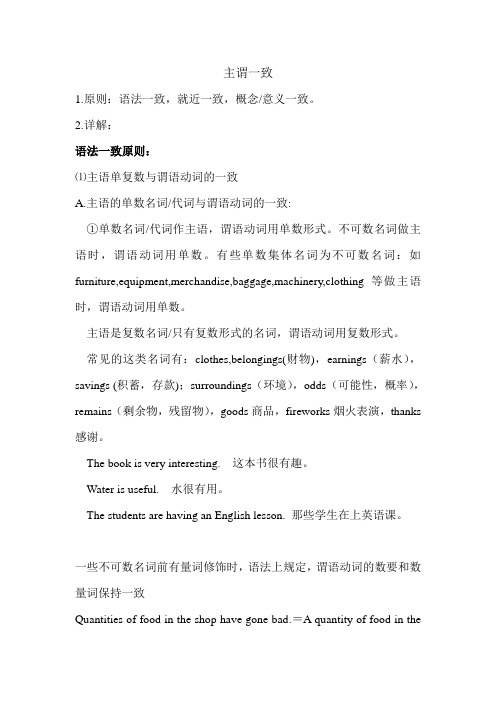
主谓一致1.原则:语法一致,就近一致,概念/意义一致。
2.详解:语法一致原则:⑴主语单复数与谓语动词的一致A.主语的单数名词/代词与谓语动词的一致:①单数名词/代词作主语,谓语动词用单数形式。
不可数名词做主语时,谓语动词用单数。
有些单数集体名词为不可数名词:如furniture,equipment,merchandise,baggage,machinery,clothing等做主语时,谓语动词用单数。
主语是复数名词/只有复数形式的名词,谓语动词用复数形式。
常见的这类名词有:clothes,belongings(财物),earnings(薪水),savings (积蓄,存款);surroundings(环境),odds(可能性,概率),remains(剩余物,残留物),goods商品,fireworks烟火表演,thanks 感谢。
The book is very interesting. 这本书很有趣。
Water is useful. 水很有用。
The students are having an English lesson. 那些学生在上英语课。
一些不可数名词前有量词修饰时,语法上规定,谓语动词的数要和数量词保持一致Quantities of food in the shop have gone bad.=A quantity of food in theshop has gone bad. 那家商店大量的食物都变质了②many a+单数名词做主语,谓语动词用单数。
Many+复数名词作主语,谓语动词用复数。
Many a worker was killed in the accident. 在这次事故中死了许多工人。
③more than one+单数名词做主语,谓语动词用单数,more +复数名词+than one做主语,谓语动词用复数。
More than one person has known it. 不止一个人知道这件事。
主谓一致的规则及应用

主谓一致的规则及应用主谓一致是英语语法中的基本规则,指的是主语与谓语在人称和数上保持一致。
正确运用主谓一致规则会增强句子的准确性和流畅性,使表达更加清晰。
本文将介绍主谓一致的规则,并给出一些应用实例。
一、基本规则1. 单数主语与单数谓语动词一致。
例如:- The cat is sleeping.(这只猫在睡觉。
)- She runs every morning.(她每天早上跑步。
)2. 复数主语与复数谓语动词一致。
例如:- The students are studying in the library.(学生们正在图书馆学习。
)- They play football every weekend.(他们每个周末踢足球。
)3. 不可数名词作主语时,谓语动词通常使用单数形式。
例如:- Rice is a staple food in many countries.(米饭是许多国家的主食。
)- Water is essential for life.(水对生命至关重要。
)4. 用作主语的不定代词通常与单数谓语动词一致。
例如:- Everyone wants to be happy.(每个人都想要快乐。
)- Somebody has left their bag here.(有人把包落在这里了。
)5. 连接词and连接的两个主语,谓语动词通常与复数一致。
例如:- Tom and Jerry are good friends.(汤姆和杰瑞是好朋友。
)- My mom and dad like gardening.(我爸爸妈妈喜欢园艺。
)二、特殊情况1. 数量词、百分数加名词短语作主语时,谓语动词取决于名词短语中的名词单复数形式。
例如:- Fifty percent of the students are girls.(百分之五十的学生是女孩。
)- A lot of money has been spent on this project.(这个项目花费了很多钱。
主谓一致的规则与例句
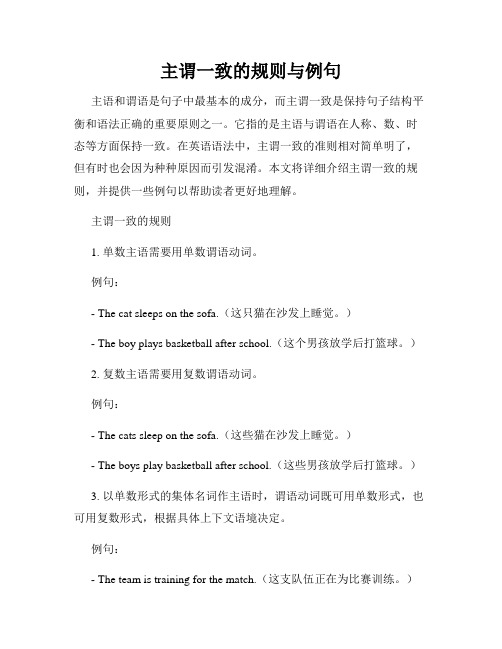
主谓一致的规则与例句主语和谓语是句子中最基本的成分,而主谓一致是保持句子结构平衡和语法正确的重要原则之一。
它指的是主语与谓语在人称、数、时态等方面保持一致。
在英语语法中,主谓一致的准则相对简单明了,但有时也会因为种种原因而引发混淆。
本文将详细介绍主谓一致的规则,并提供一些例句以帮助读者更好地理解。
主谓一致的规则1. 单数主语需要用单数谓语动词。
例句:- The cat sleeps on the sofa.(这只猫在沙发上睡觉。
)- The boy plays basketball after school.(这个男孩放学后打篮球。
)2. 复数主语需要用复数谓语动词。
例句:- The cats sleep on the sofa.(这些猫在沙发上睡觉。
)- The boys play basketball after school.(这些男孩放学后打篮球。
)3. 以单数形式的集体名词作主语时,谓语动词既可用单数形式,也可用复数形式,根据具体上下文语境决定。
例句:- The team is training for the match.(这支队伍正在为比赛训练。
)- The team are wearing their new uniforms.(这支队伍正在穿他们的新制服。
)4. 以复数形式的集体名词作主语时,谓语动词常用复数形式。
例句:- The police are investigating the case.(警察正在调查这个案件。
)- The staff are preparing for the conference.(员工们正在为会议做准备。
)5. 当主语为连接词“and”连接的两个或多个名词时,通常采用复数谓语动词。
例句:- My brother and sister are playing in the garden.(我弟弟和妹妹正在花园里玩。
)- Apples and oranges are fruits.(苹果和橙子是水果。
主谓一致的基本规则

主谓一致的基本规则主谓一致是语法中的基本规则之一,指主语与谓语在人称和数方面要保持一致。
在句子中,主语是执行动作或者被动作所作用的实体,而谓语则是描述主语所进行的动作或者状态。
正确的主谓一致能够使句子更加合乎逻辑、语法准确,使读者更容易理解句子的意思。
主谓一致的基本规则有以下几点:1. 一般情况下,单数主语与单数谓语动词相匹配,复数主语与复数谓语动词相匹配。
例如:- The cat is sleeping.(猫正在睡觉。
)- The cats are sleeping.(猫们正在睡觉。
)2. 当主语为第三人称单数时,谓语动词要加上-s或者-es。
例如:- He runs every morning.(他每天早上跑步。
)- She eats an apple.(她吃了一个苹果。
)3. 不定代词和短语作为主语时,需要根据其所指代的内容来确定谓语动词的单复数形式。
例如:- Someone is calling you.(有人在给你打电话。
)- A group of students is studying English.(一群学生正在学习英语。
)4. 当主语由连接词and连接时,只有当两个主语均为单数时,谓语动词才为单数形式,其他情况下谓语动词为复数形式。
例如:- Tom and John are going to the park.(汤姆和约翰要去公园。
)- The dog and the cat is eating.(狗和猫正在吃东西。
)5. 在使用there is和there are结构时,谓语动词的单复数形式取决于后面的主语。
例如:- There is a book on the table.(桌子上有一本书。
)- There are two cups on the table.(桌子上有两个杯子。
)总结来说,主谓一致是为了保持句子的语法规范和逻辑一致性,使读者更好地理解句子的意思。
在写作和口语表达中,我们需要遵循主谓一致的基本规则,以确保句子的正确性和可读性。
句子结构解析主谓一致的基本规则

句子结构解析主谓一致的基本规则在汉语中,主谓一致是一种基本的语法规则,指的是主语和谓语在人称、数与时态上保持一致。
主谓一致是构建正确句子结构的关键要素之一,不仅仅是汉语中,世界上几乎所有语言都存在这个规则。
下面将对主谓一致的基本规则进行解析。
1. 人称一致主语的人称与谓语动词的人称需要保持一致。
例如:- 第一人称:我喜欢读书。
- 第二人称:你去哪里了?- 第三人称:他们正在讨论这个问题。
2. 数的一致主语的单复数形式与谓语动词的单复数形式需要保持一致。
例如:- 单数主语:这本书很有趣。
- 复数主语:这些人在锻炼身体。
3. 时态一致主谓一致还需要在时态方面保持一致。
例如:- 现在时态:他们正在开会。
- 过去时态:昨天他走了。
总的来说,主谓一致是构成正确句子结构的必要条件,遵守主谓一致规则可以使句子更加准确、流畅。
在写作和口语表达中,我们需要注意主谓一致的基本规则,以避免语法错误。
此外,还有一些需要注意的特殊情况:1. 复合主语当句子中有复合主语时,主谓一致要按照就近原则来决定谓语动词的形式。
例如:- 他和他的朋友都喜欢运动。
2. 存在形式主语有些句子中的主语是“有”字结构(形式主语),谓语动词的形式由后面的实际主语决定。
例如:- 在桌子上有一本书。
3. 特殊谓语动词有些谓语动词的形式比较特殊,需要特别注意。
例如:- There is/are结构:There is a cat in the room.(房间里有一只猫。
)在写作过程中,我们要注意主谓一致的规则,保持句子结构的准确和语言的规范。
只有遵循主谓一致的基本规则,我们才能构建出流畅、准确的句子,让读者更好地理解和接受我们的表达。
主语和谓语动词的一致性理解主谓一致的原则

主语和谓语动词的一致性理解主谓一致的原则主谓一致是英语语法中的一个基本原则,指的是主语与谓语动词在人称和数上要保持一致。
这个原则可以通过以下几个方面来理解。
一、人称一致主谓一致的首要要求是在人称上保持一致。
简单来说,如果主语是第三人称单数,那么谓语动词要用第三人称单数形式;如果主语是第一、第二人称或者复数形式,那么谓语动词也要相应地使用第一、第二人称或者复数形式。
例如:- She reads books every day.(她每天读书。
)- We love to travel.(我们喜欢旅行。
)二、数的一致主谓一致的另一个要求是在数上保持一致。
即主语与谓语动词在单复数形式上要保持一致。
如果主语是单数形式,谓语动词也要用单数形式;如果主语是复数形式,谓语动词也要用复数形式。
例如:- The cat sleeps on the sofa.(这只猫在沙发上睡觉。
)- The dogs bark loudly.(这些狗大声吠叫。
)三、特殊情况在某些特殊情况下,主谓一致的原则会受到一些限制或异常情况。
以下是几种常见的特殊情况:1. 不可数名词对于不可数名词作主语时,谓语动词通常要用单数形式。
例如:- Mathematics is my favorite subject.(数学是我最喜欢的科目。
)- The information is accurate.(这些信息是准确的。
)2. 复合主语如果主语是由and连接的两个或多个名词组成的复合主语,在大多数情况下,谓语动词要用复数形式。
例如:- Tom and Jerry are good friends.(汤姆和杰里是好朋友。
)3. 连接词or、nor当主语是由or或nor连接的两个名词时,谓语动词通常与最近的名词在数上保持一致。
例如:- Neither the cat nor the dog is hungry.(这只猫和狗都不饿。
)4. 代词的一致在使用代词时,要特别注意主谓一致的原则。
初中英语语法主谓一致
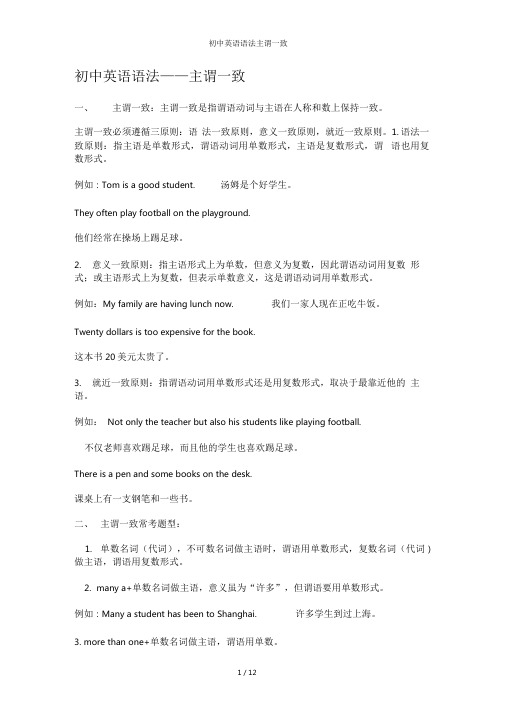
初中英语语法——主谓一致一、主谓一致:主谓一致是指谓语动词与主语在人称和数上保持一致。
主谓一致必须遵循三原则:语法一致原则,意义一致原则,就近一致原则。
1. 语法一致原则:指主语是单数形式,谓语动词用单数形式,主语是复数形式,谓语也用复数形式。
例如:Tom is a good student. 汤姆是个好学生。
They often play football on the playground.他们经常在操场上踢足球。
2.意义一致原则:指主语形式上为单数,但意义为复数,因此谓语动词用复数形式;或主语形式上为复数,但表示单数意义,这是谓语动词用单数形式。
例如:My family are having lunch now. 我们一家人现在正吃牛饭。
Twenty dollars is too expensive for the book.这本书20美元太贵了。
3.就近一致原则:指谓语动词用单数形式还是用复数形式,取决于最靠近他的主语。
例如:Not only the teacher but also his students like playing football.不仅老师喜欢踢足球,而且他的学生也喜欢踢足球。
There is a pen and some books on the desk.课桌上有一支钢笔和一些书。
二、主谓一致常考题型:1.单数名词(代词),不可数名词做主语时,谓语用单数形式,复数名词(代词)做主语,谓语用复数形式。
2.many a+单数名词做主语,意义虽为“许多”,但谓语要用单数形式。
例如:Many a student has been to Shanghai. 许多学生到过上海。
3. more than one+单数名词做主语,谓语用单数。
例如: More than one student has ever been to Beijing.不止一个学生曾经去过北京。
4.表示时间,价格,重量,数目,长度,数学运算等的词或短语做主语时,这些通常作一个整体概念,谓语用单数形式。
- 1、下载文档前请自行甄别文档内容的完整性,平台不提供额外的编辑、内容补充、找答案等附加服务。
- 2、"仅部分预览"的文档,不可在线预览部分如存在完整性等问题,可反馈申请退款(可完整预览的文档不适用该条件!)。
- 3、如文档侵犯您的权益,请联系客服反馈,我们会尽快为您处理(人工客服工作时间:9:00-18:30)。
主谓语一致主谓一致:英语句子中谓语动词的数必须与主语的人称和数取得一致,这就叫做主谓一致。
解决主谓一致主要遵循三个原则:语法一致原则、意义一致原则和就近一致原则。
一、语法一致原则1. 以单数名词或代词作主语,以从句、动词不定式、动名词或短语作主语时谓语动词使用单数形式。
主语为复数时,谓语动词用复数。
He goes to school early every morning.他每天早上很早就去上学。
(he是三人称单数)To say something is one thing , to do it is another .说是一回事,做又是另一回事。
(to say something , to do 是不定式)“How do you do?”is not a question but a greeting .(How do you do ?是句子,作主语)(注意:what 引导主语从句时应注意其所指的具体内容来确定谓语的单复数。
)What we need is more time ,while what they need are more doctors and medicines .2. 由and或both…and 连接的并列成分作主语时,谓语动词用复数。
Both he and I are right. 他和我都是对的。
Both coffee and beer are on sale in the shop .咖啡和茶在这家商店廉价出售。
※但用and 连接的两个名词表示单一概念时,也就是说如果指的是同一个人,同一事物或同一概念,谓语动词使用单数。
Bread and butter is my usual breakfast .面包黄油是我通常的早餐。
(面包黄油是一体的)3. 由两部分构成的物体的名词,如glasses, shoes, trousers,chopsticks,scissors等作主语时,谓语动词用复数。
Where are my shoes?我的鞋在哪儿?Here are some new pairs of shoes. 这儿有几双新鞋。
My new pair of socks is on the bed.我那双新袜子在床上。
4.either , neither , each , one , the other , another , anybody , anyone , anything , somebody , someone , something , everything ,everybody , everyone ,no one , nothing ,nobody 做主语时,谓语一般用单数。
Neither of the two sentences is correct .这两个句子都不对。
Everything around us is matter .我们周围的一切都是事物。
(注意:all作主语时,谓语动词一般用复数。
)All are here.5. 表示“时间、距离、金额、重量、面积、体积、容积”等度量的名词做主语时,谓语用单数Five minutes is enough . 五分钟足够了。
Four hundred francs(法郎)is a lot of money .四百法郎是一笔不少的钱。
Twenty years is not a long time.二十年不是很长一段时间。
6.each …and each …,every …and every ;no …and no ;many a …and many a …等结构由于强调个体行为,因此谓语动词使用单数。
Each boy and each girl has got a new English-Chinese dictionary .No sound and no voice is heard for a long time .7.:one and a half 后面带名词的复数,谓语动词常用单数。
One and a half bananas is left on the table .桌子上留下了一个半苹果。
8.有些名词呈复数形式,但并不表示复数概念。
The news is disappointing .9.主语是单数时,尽管后面跟有with,together with, including,but,except,besides等介词短语,谓语动词仍用单数。
The teacher with his students is going to visit the museum. 这位老师和他的学生们打算去博物馆。
10. A number of (许多)…作主语,谓语动词用复数。
The number of (…的数目) 作主语,谓语动词用单数。
A number of famous people were invited to the part.大量名人被邀请参加聚会。
The number of students in our school is 2618.我们学校的学生人数是两千六百一十八。
11. people, the police 等作主语,谓语动词用复数。
People say they are happy. 人们说他们是幸福的。
The police are searching for the thief. 警察正搜查小偷。
12. “the +形容词”表某类人,谓语动词用复数。
The old are happy in our country .我国的老人是幸福的。
临近一致的原则1.由连词or, either…or, nether…nor, not only…but also 等连接的并列主语,谓语动词按就近一致的原则,与最靠近它的主语一致。
例:Either you or I am right. 要么你对,要么我对。
Neither you nor he is correct. 你和他都不对。
Not only he but also you are invited to the party.不仅他而且你都受邀参加晚会。
2.“there be”句型中,be动词与靠近的主语一致,例:There are two apples and one egg in it.有两个苹果和一个鸡蛋在那儿。
There is one pen and two books on the desk.桌子上有一支钢笔和两本书。
3. as well as 和名词连用时,谓语动词和第一个名词相一致。
例:He as well as I is interested in the film.我和他都对这部电影感兴趣。
4. 以here开头的句子,其谓语动词和靠近的主语一致。
Here is a letter and some books for you.这儿有一封信和一些书给你。
主谓语一致专项练习( )1.Swimming in the pool with friends _________ very interesting.A.hasB.haveC.isD.are( )2.Yesterday,Tony’s family ________ a good time.A.hasB.haveC.had( )3.____________ trees have been cut down, so droughts and floods always happen.A.One or twoB.A thousand and a hundredC.Hundreds and thousands of( )4. ___________ often play basketball on the ground.A. The boyB.The boysC.A boy ( )5.I like pop music,but ________ my father _____ likes it.A.both;andB.either;orC.neither;nor ( )6.There _____ two boys playing under the tree.A.haveB.areC.isD.has ( )7-Do you know _______ the population ofYunnan ______ ?-Yes,It’s about forty – three million.A.how much;isB.what; isC.how many; areD.what;are( )8.The woman with two children _________ for the bus that is to come.A.are waitingB.is waitingC.were waitingD.was waiting( )9.The teacher,with 6 girls and 9 boys of her class,_______ visiting a museum when theearth-quake took place.A.wasB.wereC.isD.are ( )10.Not only the students but also Mr Green ________ tired of having an examination afteranother because they want more free time.A.isB.areC.wasD.were ( )11. Everyone except Tom and John _____ seen the film.A. isB.hasC.areD.have ( )12.The woman behind the girls ____ a famous actress.A. isB.areC.haveD.has ( ) 13. _______ you _______ he is able to skate,but I am.A. Both; andB.Not only; but alsoC.Either; orD.Neither; nor( )14. What _____ the number of the students in your school? About two thousand. A number of them____ from England.A. is; areB.is ;isC.are; isD.are; are ( )15.Either Eve or Herb _____ been invited by Lucy’s parents already.A. haveB.hasC.wasD.were( )16. There _____ some milk,two eggs and a few cakes on the table.A. isB.areC.hasD.have ( )17. There _____ a post office and two hotels near here.A. isB.areC.hasD.have ( )18. –How well Anna dances! I can’t believe my eyes!-_________ .A. So she doesB. So does sheC. Neither can sheD. So can I( ) 19.-I hear Yang Yan made an English speech at the graduation ceremony yesterday.- ________,___.A. So she did; so did IB.So did she; so I didC.So she was; so I wasD.So was she; so I was ( )20.-My parents never stop going on about (唠叨) how I should study hard.- ___________ .A. So my parents doB. Nor my parents doC. Nor do my parentsD. So do my parents ( )21.There _____ a lot of rain in this area in August every year.A. isB.wasC.areD.were ( )22.Both Jim and Kate _____ in Beijing now. They both ______ from America.A. is ; comeB.are; comeC.is; comesD.are; comes( )23.This is my twin sister Lucy. Both she and I ______ good at drawing.A. amB.isC.areD.be ( )24. One of my friends ______ already moved to London.A. doB.doesC.haveD.has ( )25. -I am interested in science. What about you?- ____________ .A. So do IB. So am IC. So I am ( )26. –How well Anna dances! I can’t believe my eyes!-_________ .A. So she doesB. So does sheC. Neither can sheD. So can I。
